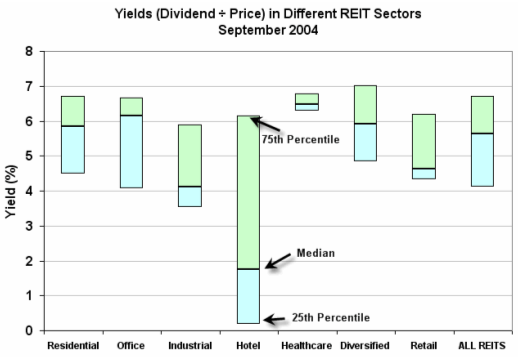Guide to REIT Dividends (Real Estate Investment Trusts)
Post on: 19 Июнь, 2015 No Comment

What Is a Real Estate Investment Trust (REIT)?
Real estate investment trusts, or REITs, are companies that focus the majority of operations in real estate. These companies are usually in the business of owning and acquiring properties or acting as landlords. It is beneficial for a company to become a REIT as it results in no income tax obligations on the corporate level. Instead, these taxes are passed on to the individual investors. In return, these companies distribute at least 90% of earnings to shareholders in the form of dividends, resulting in very high yields.
REIT Dividend Tax Rate
A common question that dividend investors have is: are REIT dividends qualified? These dividends are usually not qualified, meaning that they do not qualify for the capital gains rate of 15%. Instead, these dividends are taxed at the investors regular income tax rate. For detailed information on REIT taxes, check out The Complete Guide to REIT Taxes .
How to Invest in REITs?
REITs can be purchased through any major broker just like a stock. For a full list of dividend paying REITs, click here. For additional commentary, check out Ameritrades guide to REIT investing.
REIT History and Structure
Real estate investment trusts were first created in 1960 by Congress to enable both small and large investors to benefit from commercial real estate profit. The government requires REITs to abide by several regulations, including maintaining 75% of their assets and income in real estate, and having a minimum of 100 shareholders.
In addition, REITs must distribute 90% of their earnings to shareholders through dividends. As a result, the company is exempt from paying income taxes on the profits paid to shareholders. In turn, individual shareholders are then responsible for paying taxes on earned dividends. REITs generally have very high yields and payout ratios since they are required to pay such a large percentage of their profits in the form of dividends. In fact, payout ratio is not a useful metric for evaluating REITs at all. The payout ratio is useful for evaluating other dividend-paying stocks; find out more about it in The Truth About Dividend Payout Ratio .
The first REIT to be listed in the New York Stock Exchange was Continental Mortgage Investors in 1965. Europe was not too far behind, as it passed the first European REIT legislation in 1969.

The two main kinds of REITs are equity and mortgage. Equity REITs focus on property management. Although these firms do finance their properties, they increase income by making acquisitions and managing properties. In contrast to equity REITs, mortgage REITs do not own or manage their properties. They earn their income by investing in real estate loans.
REITs are often categorized depending on the specific type of property that they invest in. Approximately two thirds of REITs are in offices, apartments, shopping centers, malls, and industrial facilities. The remaining REITs own properties such as hotels, health care properties, and self-storage facilities.
Below are the most common types of REITs:
Healthcare REITs
Healthcare REITs own real estate properties such as hospitals, medical centers, nursing facilities, and retirement homes. These REITs depend on factors such as occupancy fees, Medicare and Medicaid reimbursements, and private pay to be successful.
The performance of these companies is directly impacted by the state of the health care system. Below are some of the largest healthcare focused REITs. For a full list of healthcare REITs, click here .














